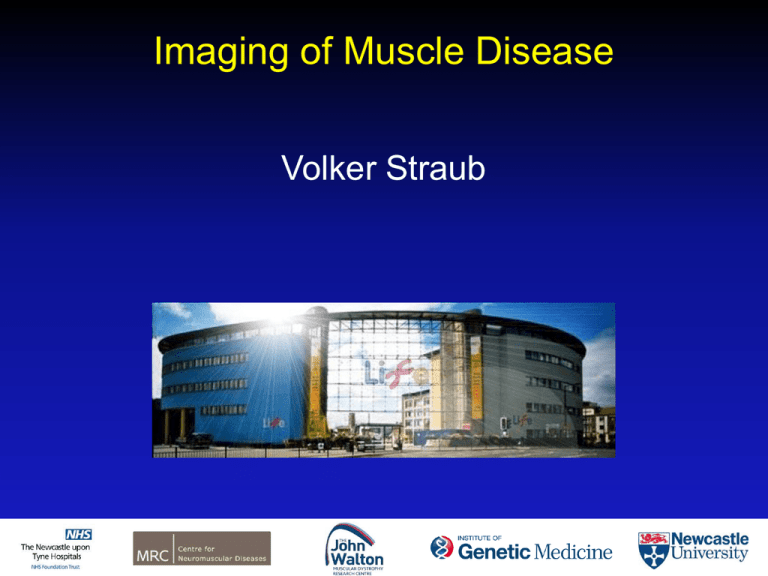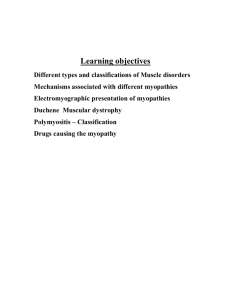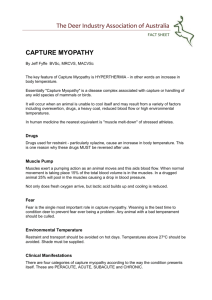Volker Straub
advertisement

Imaging of Muscle Disease Volker Straub What’s the role of MRI in the diagnosis of genetic muscle diseases? Volker Straub Pattern recognition – the quiz MRI is a tool for different applications Pattern recognition e.g. T1w outcome measures quantitative MRI, e.g. Dixon technique, T2 Pathophysiology contrast agents, Diffusion tensor imaging texture analysis algorithms Fundamentals of MRI 1.5 vs 3–tesla MRI High field strength MRI provides a better signal to noise ratio. At the same resolution, images on a higher field strength magnet can be acquired faster. mritechniciansite.com Fundamentals of MRI Frontal or coronal plane divides the body or an organ into front (anterior) and back (posterior) portions Transverse (cross-sectional), axial or horizontal plane divides the body or an organ into upper (superior) or lower (inferior) portions Whole Body MRI Cardiac MRI http://upload.wikimedia.org/ Mohit Joshi, 08/21/2010, www.topnews.in/health/ Pattern recognition by muscle MRI – a diagnostic or a research indication? 51 y. of age 15 y. history of weakness CK 680 U/l Bethlem myopathy 43 y. of age 6 y. history of weakness CK 840 U/l Pompe disease diagnostic procedures in muscle diseases clinical history clinical examination investigations blood tests electrophysiology cardiac function lung function imaging muscle biopsy protein analysis genetic analysis confirmed diagnosis diagnostic procedures in muscle diseases clinical history clinical examination investigations blood tests genetic analysis electrophysiology cardiac function lung function imaging muscle biopsy protein analysis confirmed diagnosis Stanford MSK MRI Atlas 1.0 Stanford MSK MRI Atlas 1.0 which diseases might a muscle MRI help to diagnose? Muscular Dystrophies Myofibrillar Myopathies (congenital) Myopathies LGMD2I - Descriptive analysis Thigh muscles; T1 weighted LGMD2I - Descriptive analysis Calf muscles; T1 weighted LGMD2I - quantitative analysis Muscle Biceps Femoris long head (BFLH) Semitendinosis (ST) Semimembranosis (SM) Biceps Femoris short head (BFSH) Sartorius (SAR) Vastus Medialis (VM) Gracilis (GRAC) Vastus Lateralis (VL) Rectus Femoris (RF) Medial Gastrocnemius (MG) Lateral Gastrocnemius (LG) Peroneus Longus (PL) Soleus (SOL) Tibialis Anterior (TA) Median LGMD2I 69.7 Median Control 3.9 49.0 48.6 25.5 2.3 2.9 3.2 24.2 23.3 16.4 14.3 9.4 25.1 19.4 16.0 10.5 5.9 3.9 5.5 3.0 2.9 3.3 2.2 2.0 4.9 3.0 2.8 thigh lower leg Table 2; The median values of fat infiltration (%) in the patient group and the control group. Willis T. et al., PLOS one 2013 LGMD2I thigh LGMD2I – assessment of muscle pathology by MRI Selective pattern of involvement LGMD2L – anoctamin5 proximal weakness of lower limbs + high CK! LGMD2L – anoctamin5 UK9 UK7A UK5B Sarkozy A. et al., Neuromuscul Disord 2012 LGMD2L – anoctamin5 UK5A UK1A UK11 Sarkozy A. et al., Neuromuscul Disord 2012 LGMD2L – anoctamin5 Schematic representation of muscle involvement. Red: most severely affected muscles; green: least affected muscles 29 y old female, CK 2.500 U/l, limb girdle weakness LGMD2A Typically involvement of the hamstring and the medial gastrocnemius and soleus muscles 46 y old male, high CK, limb girdle weakness Sparing of the lower leg muscles in a patient with limb girdle muscular dystrophy: Think of the sarcoglycanopathies or Pompe disease! Myofibrillar Myopathies (desminopathies, protein surplus myopathies) Desmin Myotilin ZASP B-Crystalin Filamin C BAG3 DNAJB6 Titin VCP Desmin associated myopathy The most affected muscles are: Thigh: the semitendinosus, sartorius and gracilis muscles Calf: the extensor digitorum longus musles Myotilin associated myopathy The most affected muscles are: Thigh: the adductor magnus and semimembranosus muscles Calf: the soleus, medial gastrocnemius and tibialis anterior musles 50 y old female with sequence variants in ZASP, titin, myotilin and desmin desmin myotilin Straub et al., Neuromuscul Disord 2012 Myofibrillar Myopathies MUSCLES DES CRYAB MYOT ZASP Peroneus 9/9 3/4 6/11 1/2 Soleus 1/9 2/4 11/11 2/2 Semitendinosus 9/9 4/4 0/11 0/2 Semimembranosus 0/9 0/4 11/11 1/2 Sartorius 9/9 3/4 2/11 0/2 Gracilis 6/9 4/4 0/11 0/2 Vasti intermedius/medialis 1/9 1/4 7/11 1/2 desmin myotilin Straub et al., Neuromuscul Disord 2012 Titin associated myopathy 62 year old male 40 year old male Muscle imaging findings in GNE-myopathy G. Tasca et al., J Neurol (2012) Muscle imaging findings in GNE-myopathy muscles prominently and invariably involved from the early stages of GNE myopathy include: • the gluteus minimus (a red) • the biceps femoris short head (b green) • the tibialis anterior (c blue) • the extens. hallucis/digitorum longus (c yellow) • the soleus (c violet) • the gastrocnemius medialis (c orange) the femoral quadriceps muscle is normally well preserved G. Tasca et al., J Neurol (2012) 51 year old female with an axial, non-progressive myopathy RYR1-associated myopathies Arch Neurol 2011 MTM1, manifesting carrier SEPN1 associated myopathy (RSS) Mercuri et al., Ann Neurol 2010 SEPN1 associated myopathy (RSS) Bethlem Myopathy Collagen VI-related disorder Bethlem Myopathy Ullrich CMD Mercuri et al., Ann Neurol 2010 Bethlem Myopathy STIR images have very low signals from fat but high signal from fluid 45 year-old woman with thigh pain and swelling This is a case of pyomyositits Coronal STIR image reveals a fluid collection in the mid right thigh, with extensive soft tissue edema. (A) Axial T1 and (B) Axial STIR images show that the fluid collection is associated with the vastus intermedius muscle. (http://musculoskeletalmri.blogspot.co.uk/) FSHD T1w T2-STIR Tasca G et al. PLoS One. 2012 Frisullo G et al. J Clin Immunol. 2011 A diagnostic algorithm for LGMD using muscle MRI Myofibrillar myopathies Applications of MR imaging and spectroscopy techniques in neuromuscular disease: collaboration on outcome measures and pattern recognition for diagnostics and therapy development DICOM sharing: Web-based online atlas: Users can access and search all uploaded scans curated images with descriptions and annotations, linked back to DICOM source Central online PACS Scans from all collaborating centres Anonymization Stage 1: Better image sharing Stage 2: Development of curated public resource Stage 3: Future-proofing Pattern recognition – the quiz Titinopathy LGMD2A RYR1 Pompe LGMD2L desminopathy Myotilinopathy SEPN1 (RSS) Bethlem Thank You Institute of Genetic Medicine, Newcastle upon Tyne, UK







